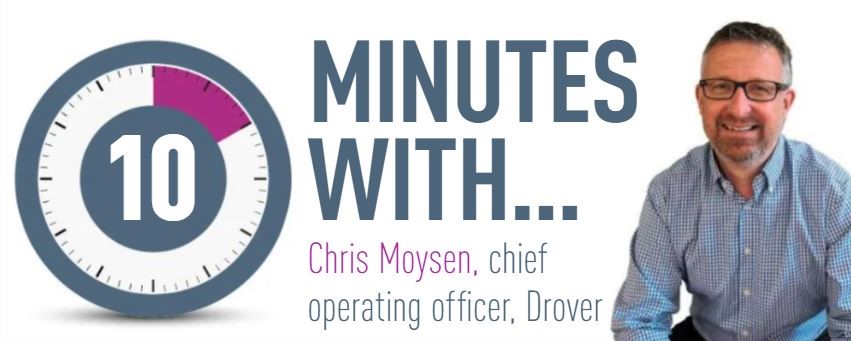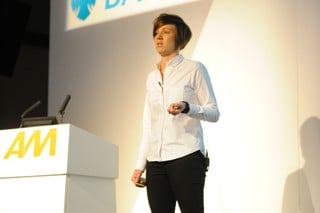What have been the big milestones for you in the past 12 months?
The major change has been how we operate. We have centralised the way we group stock going through the platform so there is one paper trail and one logistics partner through FleetAssist. We’ve ‘Droverfied’ the service.
It’s had a massive impact for our cost base, but also on the consistency of service we provide.
We have also launched in France around the Périphérique Paris ring road and that’s the first phase of our planned international expansion.
We’ll launch in other areas of France next year and into other European markets too.
We don’t want to run before we can walk though, so we’ll continue to refine what we do in the UK and build a model we can roll out in other markets.
How is that £20.5 million in new investment going to help you scale up the business in the UK?
We’ll be investing in tech development for our website but also to improve the functionality of our app.
We also want to improve the servicing and maintenance experience for our customers through our app.
There will also be some key executive hires and marketing spend to boost our brand awareness.
How are you going to make Drover a household name?
That’s certainly our ambition. Channel 4 is one of our recent investors and so we have a relationship with them for our TV advertising and that will continue.
We’ll continue to invest in social media and digital marketing to promote what our offer is all about, but we’ll also invest in brand marketing.
Do you like the term “The Netflix of Cars” that often gets associated with Drover?
I think if we could even get to a 5% market value of Netflix we would be over the moon. I understand why that phrase is used because I think it highlights how the world is changing.
The average age of our customers is 39 and they are very used to subscription services like Netflix, Spotify and paying for their smartphone through contracts.
How many customers do you have in the UK and what is the potential for growth?
We have 4,000 live subscribers in the UK and around 60% currently have a car (2,500). The average monthly subscription price is around £399 and that includes insurance, maintenance, MOT, breakdown cover and tax as part of the package.
The average subscription length before switching is close to 16 months.
Around 40% of our customers are women under 40. I think that tells you something about the way that particular customer demographic would prefer to choose their next car.
We think online car sales will take around 10% of the UK new car market by 2025 and that represents a big opportunity for us.
Buying online still only represents approximately 1% of the market. Why is it going to build to 10% in five years?
There will always be those who want to go into the showroom or complete finance agreements at the dealership, but that’s not our customer.
Our customers want to do everything digitally, they want to be able to choose a car in the comfort of their own home and have it delivered to them and, most importantly, they want flexibility.
Our target customers want a vehicle packaged up in a box, with everything included. They want to get from A to B and they don’t want to be locked in for three years.
COVID-19 will change how many people are driving and commuting due to more people working from home.
I don’t think people are going to want to be locked into long contracts and they want the flexibility to swap or stop with a month’s notice.
In the Netflix age, why haven’t online car sales exploded?
It’s partly because there isn’t the facility for some dealer groups or OEMs to make it happen.
That is getting better and more and more are launching online car sales platforms. We’re doing our part too.
What’s the appetite for dealer groups to offer their stock through the platform?
We’re currently working with around 12 major dealer groups in the UK. They are part of how we source vehicles, which also come through leasing companies and rental companies.
We would obviously like to increase the number of dealers we’re working with as supply is the biggest issue for us right now. We have a lot of demand, but we need more vehicles.
What do dealer groups get out of the partnership?
Talking about return on investment is a difficult subject because it can totally depend on the objective for each dealer group. We have two ways that dealer groups will supply vehicles to us.
They either like to register the vehicle themselves and then list it on our platform and then we’ll give them an indication of what they can earn from that vehicle before they set their own price. Or some dealers might sell vehicles to us directly. There can be a variety of reasons behind engaging with us.
Some dealers might be looking to push volume to meet targets or find they have too much stock they want to offload. Some might have an influx of PCP returns they want to put through to us, for example.
What’s the biggest growth opportunity for Drover?
We’ve seen a spike in interest for plug-in vehicles on our platform. Again, supply is our main issue with getting enough electric and hybrids vehicles to satisfy demand.
Trying out a plug-in vehicle with no risk of being locked into a contract is really appealing to people that aren’t sure whether it fits with their lifestyle.
On our platform you could try a battery electric vehicle, a mild hybrid, a plug-in hybrid and switch between them easily and see how they work for you.
What are the big innovations you’re excited about right now?
Connected features that link between the car, services and apps is really interesting.
We have around a third of our fleet connected with plug-and-play telematics and that is feeding back information to us around vehicle utilisation and predictive maintenance.
We’re hoping to get to 100% of our fleet connected by the end of the year. There is going to be more we can do to link vehicles to services in the future and that’s something we’re looking at right now.
What do you see as the biggest threats to your business this year?
Supply. Many manufacturers aren’t sure what’s going to happen in the market and they’re not sure which way to go.
We have been supply-constrained for the past 12 months. We only have around 200 vehicles that we are taking the residual risk for right now, that will probably change in the future, but we need to be looking at what happens to residual values in Q4.
That may actually turn into an opportunity for us. If values crash, some dealers may look to offload their used car stock to us, which will help boost our supply.
What’s your view on the value proposition for car subscriptions vs PCP?
Our mission is all about making getting you a car as easy as possible. We have three general price points at around £399, £499 and £599.
Some customers are going to prefer to continue being locked in to a PCP deal at the value end of the market, but we think there are customers out there that will pay a bit more for the flexibility and all-in-one package.
What’s to stop manufacturers or dealer groups building their own Drover-style platform?
We would be foolish to think that it’s not a threat, but I haven’t seen a company that has done it successfully yet.
A lot of long-established companies like leasing companies have legacy systems that don’t put them in a position to easily innovate.
I think daily rental and dealer groups are probably the best placed to build their own rival platforms, but, at the same time, I think they’re also not too precious about where their revenue is coming from.
Our background is in tech and we have the systems in place already. So, partnering with us, rather than investing millions into their own system will make more sense for most.
What do you think is the greatest threat to the franchised dealer model?
Burying your head in the sand. Car sales are going to move online and feature more digital elements as part of that journey. Retailers need to do everything they can to make buying online as easy as possible and those that don’t are going to struggle.




















Login to comment
Comments
No comments have been made yet.